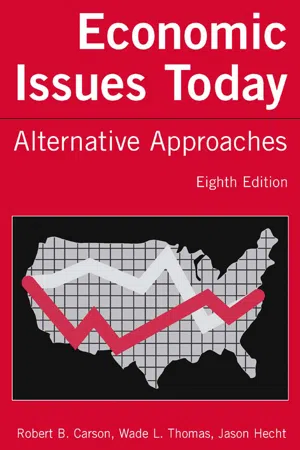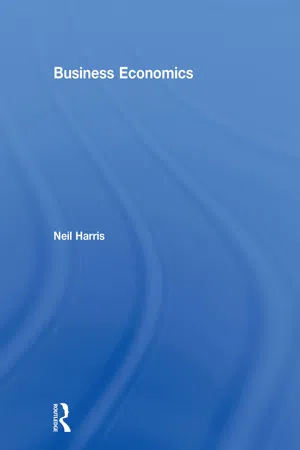Economics
Macroeconomic Questions
Macroeconomic questions pertain to the study of the economy as a whole, focusing on factors such as inflation, unemployment, economic growth, and government policies. These questions seek to understand the broader impact of economic decisions and events on society, and they often involve analyzing aggregate measures such as GDP, national income, and overall price levels.
Written by Perlego with AI-assistance
Related key terms
3 Key excerpts on "Macroeconomic Questions"
- eBook - ePub
Economic Issues Today: Alternative Approaches
Alternative Approaches
- Robert B. Carson, Wade L. Thomas, Jason Hecht(Authors)
- 2015(Publication Date)
- Routledge(Publisher)
Part IIIProblems of Aggregate Economic Policy
Part III focuses on issues that are primarily macroeconomic in origin. In other words, our attention will be directed to issues affecting the economy as a whole and to variables affecting its aggregate economic performance. Specifically, we shall examine such problem areas as business cycle behavior, stabilization policy, the federal deficit, unemployment, inflation, international trade and monetary policy, and the changing demographics of the nation’s population. Part II examined problems of specific economic units—households, firms, industries, labor groups, and the like. As one economist described the difference between microeconomics and macroeconomics, the former examines the trees, while the latter studies the forest.Passage contains an image
Issue 8
Macroeconomic Instability
Are We Depression-Proof?
We have nothing to fear but fear itself.—President Franklin D. Roosevelt, 1933This is a unique moment in U.S. history, a time of unrivaled prosperity and progress, with few internal crises or external threats. We have the responsibility to use our good fortune wisely. If we maintain our current economic strategy, we can sustain our prosperity, expand the circle of opportunity, meet the long-term challenges of this new century, and provide our children the chance to live their dreams.—President Bill Clinton, 2001The economy of the United States has been through a lot. If you really think about it, it’s pretty remarkable to be able to stand up and say to you that our economy is strong and getting stronger, that we’re witnessing steady, consistent growth. After all, we’ve been through a recession, a national emergency, a war, corporate scandals.—President George W. Bush, 2004In world market crisis, the contradictions and antagonisms of bourgeois production break through to the surface. But instead of investigating the nature of the … catastrophe, the apologists content themselves with denying the catastrophe itself. - eBook - ePub
- Kenneth M. Eades, Timothy M. Laseter, Ian Skurnik, Peter L. Rodriguez, Lynn A. Isabella, Paul J. Simko(Authors)
- 2010(Publication Date)
- Wiley(Publisher)
The Wealth of Nations, published in 1776. Resource allocation is determined in a market system by reactions to and changes in prices. While the mechanics are rather simple, the implications for society and the belief that firms and markets are valuable social institutions rest in large part on the ideas embodied in supply and demand analysis.A Shift in SupplyExhibit 2.3It is not from the benevolence of the butcher, the brewer or the baker that we expect our dinner, but from their regard to their own self interest…. [Every individual] intends only his own security, only his own gain. And he is in this led by an invisible hand to promote an end which was no part of his original intention. By pursuing his own interest, he frequently promotes that of society more effectually than when he really intends to promote it.—Adam SmithMacroeconomics
Whereas microeconomics focuses on individual and firm-level decisions, macroeconomics focuses on the broad state of the economy. When people ask, “What’s the economy doing?” or “What’s the state of the stock market?” they are asking about the macroeconomy. Macroeconomics employs tools and concepts that help us to think about and predict the level of unemployment, the rate of inflation, rates of economic growth, the level of interest rates, and the policies governments pursue to influence them. Because ultimately the impact of policies depends on the behavior of individuals and firms, macroeconomics does not ignore microeconomic analysis. Models of macroeconomic behavior are rooted in ideas and evidence of how individuals react to changes in their environment. Macroeconomic models range from the simple to the incredibly complex, and all embody some key relationships that we discuss in the remainder of this chapter.To begin with, we can represent what goes on in the economy with a supply and demand graph very similar to those used in the microeconomics section. Exhibit 2.4 is such a graph. Notice that we have appended an A to the D and S to note that we are now dealing with aggregate demand (AD) and aggregate supply (AS). By aggregate, we mean the value of all of the goods and services produced in the economy during a period of time. The more common phrase for this value is the gross domestic product (GDP) of the economy. Since the AD - eBook - ePub
- Neil Harris(Author)
- 2007(Publication Date)
- Routledge(Publisher)
The case study above illustrates aggregate demand and the factors influencing it, particularly growing consumer confidence, or the ‘feel-good’ factor as journalists call it. It also focuses on the major area of consumer spending, housing, and shows the impact of rising consumer confidence and hence expenditure, financed by borrowing, on house prices. Therefore, businesses, in this case study house builders, need to know the current state of the economy and how consumers will react. They also need to know how the economy will develop in the short to medium term future, government macroeconomic policies, and their impact on the economy. Most importantly for businesses, growing consumer confidence should translate into higher expenditure on products which will cause businesses to produce more.The focus of this chapter, and subsequent ones is, therefore, on the relationship between businesses and the macroeconomy. One of the problems of macroeconomics, compared with microeconomics, is that there are a number of competing schools of thought as to how the macroeconomy works and the policies to be adopted to manage it effectively. These schools of thought are classified as the Keynesians, the Monetarists, the new Classical economists and the New Keynesians. The reader who wants to explore these in depth is referred to standard economic texts identified in the further reading section. This book does not have the scope or the space to do so. Rather, it seeks to discuss generally accepted theories of macroeconomics, their implications for businesses and how the latter react to economic change, both within the UK economy and externally.DefinitionsWe begin our exploration of macroeconomics by defining national product.National ProductWhen examining microeconomics we saw that, if demand equalled supply, this determined the equilibrium price and quantity. Similarly, we can examine the economy and calculate the quantity of output of goods and services supplied by all businesses, however defined. This is called national product. However, in the economy as a whole, there is no guarantee that aggregate demand will automatically equal aggregate supply; we return to this later. In the meantime, there are several definitions of national product to consider.
Learn about this page
Index pages curate the most relevant extracts from our library of academic textbooks. They’ve been created using an in-house natural language model (NLM), each adding context and meaning to key research topics.


